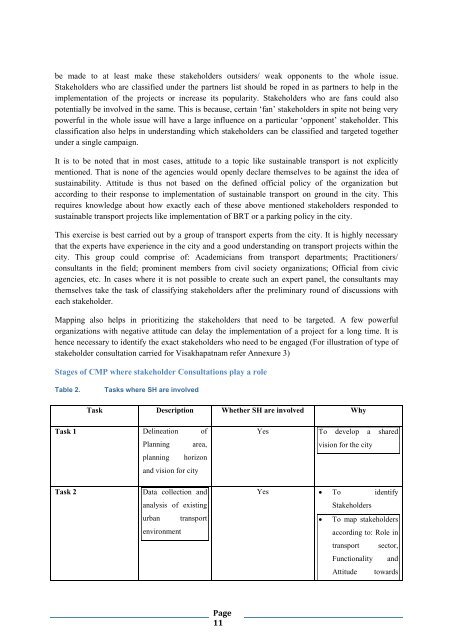Toolkits for Urban Transport Development - UNEP
Toolkits for Urban Transport Development - UNEP
Toolkits for Urban Transport Development - UNEP
You also want an ePaper? Increase the reach of your titles
YUMPU automatically turns print PDFs into web optimized ePapers that Google loves.
e made to at least make these stakeholders outsiders/ weak opponents to the whole issue.<br />
Stakeholders who are classified under the partners list should be roped in as partners to help in the<br />
implementation of the projects or increase its popularity. Stakeholders who are fans could also<br />
potentially be involved in the same. This is because, certain ‘fan’ stakeholders in spite not being very<br />
powerful in the whole issue will have a large influence on a particular ‘opponent’ stakeholder. This<br />
classification also helps in understanding which stakeholders can be classified and targeted together<br />
under a single campaign.<br />
It is to be noted that in most cases, attitude to a topic like sustainable transport is not explicitly<br />
mentioned. That is none of the agencies would openly declare themselves to be against the idea of<br />
sustainability. Attitude is thus not based on the defined official policy of the organization but<br />
according to their response to implementation of sustainable transport on ground in the city. This<br />
requires knowledge about how exactly each of these above mentioned stakeholders responded to<br />
sustainable transport projects like implementation of BRT or a parking policy in the city.<br />
This exercise is best carried out by a group of transport experts from the city. It is highly necessary<br />
that the experts have experience in the city and a good understanding on transport projects within the<br />
city. This group could comprise of: Academicians from transport departments; Practitioners/<br />
consultants in the field; prominent members from civil society organizations; Official from civic<br />
agencies, etc. In cases where it is not possible to create such an expert panel, the consultants may<br />
themselves take the task of classifying stakeholders after the preliminary round of discussions with<br />
each stakeholder.<br />
Mapping also helps in prioritizing the stakeholders that need to be targeted. A few powerful<br />
organizations with negative attitude can delay the implementation of a project <strong>for</strong> a long time. It is<br />
hence necessary to identify the exact stakeholders who need to be engaged (For illustration of type of<br />
stakeholder consultation carried <strong>for</strong> Visakhapatnam refer Annexure 3)<br />
Stages of CMP where stakeholder Consultations play a role<br />
Table 2.<br />
Tasks where SH are involved<br />
Task Description Whether SH are involved Why<br />
Task 1 Delineation of<br />
Planning area,<br />
planning horizon<br />
and vision <strong>for</strong> city<br />
Yes To develop a shared<br />
vision <strong>for</strong> the city<br />
Task 2<br />
Data collection and<br />
analysis of existing<br />
urban transport<br />
environment<br />
Yes To identify<br />
Stakeholders<br />
To map stakeholders<br />
according to: Role in<br />
transport sector,<br />
Functionality and<br />
Attitude towards<br />
Page<br />
11
















